Case 6: Live music at Artbox Bangkok Exhibition Flea Market
The aforementioned nostalgic soundscapes can be set in contrast to the musical soundscapes of the “present.” Outdoor live music shows in Bangkok may sometimes reveal the musical preferences of the middle class and younger generation. For people from European countries, such as Germany, spending a weekend in a (shipping) container-built market with live music and beer may not sound new, but for many locals in Bangkok it is a novel adventure. Alongside the pop and rock music performances held on site, Artbox Bangkok Container Market hasconstructed an urban soundscape that incorporates the music favoured by the young Thais in Bangkok. Unlike the Muay Thai matches in Ratchadamnoen Stadium, the live music in the open-air market show contains no trace of Thai traditional music, but pop and rock tunes from outside the country. The only “Thai” feature to be heard are perhaps the lyrics. With the lack of traditional musical instruments, one might not be convinced that this music really represents the city or even Thailand. However, if the surrounding sonic nuances – such as the sounds of vendors (mostly selling European snacks, pastries and desserts) – are taken into account, the soundscape projects a rather precise aural image of cultural trends in Bangkok.
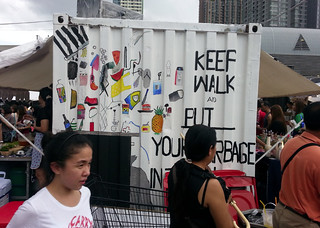
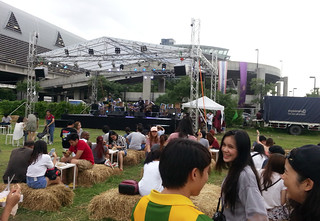
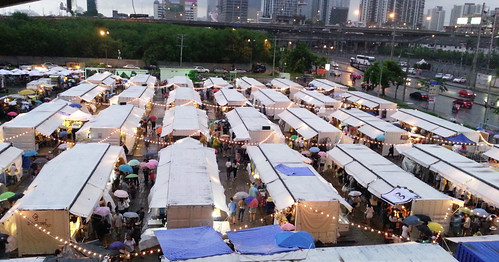
Picture 11, 12, and 13. Artbox Bangkok, Episode 4: “When I was young,” outside Makkasan City Terminal, Bangkok
Audio file 8: Artbox Bangkok, Episode 4
Audio file 9: Artbox Bangkok, Episode 4
Case 7: Mor Lam (หมอลำ) performance near Chao Phraya River
Audio file 10: Mor Lam (หมอลำ) performance at Sathorn Transit Pier

Picture 14. Mor Lam (หมอลำ) performance at Sathorn Transit Pier in Bangkok
The picture of an urban musical soundscape in Bangkok cannot be complete without mention of the influence of Mor Lam street performances. Originated in Laos and Isan (a/the northeastern region in Thailand), Mor Lam is a prominent music genre in Thailand. In audio file 10, a student improvises freely with an electric phin (พิณ), a local version of the Western electric guitar. The “modernized” Mor Lam is strongly influenced by American bluegrass music. A donation box with notes next to her indicates that she is raising money for her studies. The melodic line sounds completely Thai in its tonal structure, but the use of electronic looping is definitely an imported musical technique. A typical example of Bangkok street music of a cross-cultural nature, traditional Thai plucked string music is married with music originating in North America.
Innovative though it might sound, most locals, nevertheless, seem apathetic to her performance, passing by without paying much attention to her. Some foreigners stop for a while, clapping their hands occasionally. Mor Lam can be regarded as a localized music genre in Bangkok and Thailand. It is asserted that the modern version of Mor Lam does not preserve its original social function as moral education (Wannaudom n.d.). This street performance, however, exemplifies the contemporary Mor Lam music culture and performance practice at both local and regional levels.
Case 8: Japanese children’s music at a Thai Shopping Mall and Khao San Road
Indeed, urban soundscapes do not always transmit aural localities. The sonic mix can consist exclusively of imported phenomena through global capitalism and international consumerism. The Daiso Stores best illustrate this observation. The significance of Japanese investment in Thailand is partially reflected in their retail chain stores. For example, the Japanese budget stores Daiso are located in shopping malls associated with the family-owned conglomerate Central Holding (กลุ่มเซ็นทรัล). Foreign music is omnipresent in these stores merchandising imported products. The audio file below contains Japanese children’s songs being projected from speakers near the ceiling in a Daiso store, including Mushi No koe (蟲のこゑ), Issun-bōshi (一寸法師), Ike no koi (池の鯉), and Kintaro (金太郎), respectively. Walking around the store creates a sonic sojourn, as if the customer is shopping in Japan, reinforced by visual decorations mimicking a shopping experience in a Daiso store in Japan.
Audio file 11: Daiso Store

Picture 15. Daiso store at Central Salaya shopping mall
Case 9: Techno-pop at Khao San Road

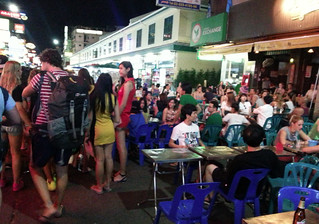
Picture 16 and 17. Khao San Road in Bangkok
If one were to play only the audio file below in a presentation, without mentioning the location, it may be difficult to identify the sound source as being the Khao San Road in Bangkok. Similar to the case study of the Daiso Store, Khao San Road is another example of a soundscape dominated by imported music. The resulting sounds, arising primarily from tourist activities, convey hardly anything about local lives, with the exception of some tourist-focused street performances and local vendors.
Audio file 12: Khao San Road
Khao San Road, visually, reveals some cult practices in this vibrant city. It is indeed a distinct community. The soundscape shared here represents the dominance of global tourism. It can be said that the travellers and backpackers in Bangkok are integral to the city, characterising it as a centre of tourism in Southeast Asia. Gathering and strolling along Khao San Road have become a leisure activity for some locals as well, especially young Thais. Thus the representational value of audio-only documentation of this area is a debatable subject.
Introduction
Southeast Asia has often been regarded as an intermediate zone between the ancient civilisations of China and India. Historically, this region, encompassing diverse cultures and religions, has experienced Indianisation, Islamisation and Westernisation, with a history of colonialism since the 16th century. Throughout the Second World War and Cold War, the region has been a conflict zone and diplomatic battleground between superpowers, alongside frequent civil wars, anti-colonial insurrections, and inter-communal massacres (Bayly and Harper 2007). Recent studies have argued that Southern China and Southeast Asia should be perceived as one region (Lombard 2007). The recent establishment of the ASEAN Economic Community (AEC), the economic and migrational impact of China, as well as terrorist attacks in the region, have been drawing attention from the international community.
Bangkok and Hong Kong are two open societies, encompassing eclectic cultural practices and shifting demographic patterns due to their regional politics and economic transformations. A major source of exotic experience in global tourism, Bangkok has been perceived as an enticing destination, especially for holiday-goers from Europe and North America. As a former British colony, Hong Kong had been an international trading port, with economic prosperity and political stability secured partly due to the rule of the British government until 1997. Thai and Cantonese, both tonal languages, are spoken in Bangkok and Hong Kong, respectively. Geographically located within Southeast Asia, they have been populated by migrants from mainland China over centuries (Baker and Phongpaichit 2009). One of the wealthiest dialect groups is composed of the descendants of “Chiu-Chow” (潮州), whose ancestors originated in South China, also known as “Teochew” in Thailand (Tong and Chan 2001, Yen 2013). During 2013 and 2014 the two cities witnessed massive protests and the occupation of governmental buildings due to prolonged political tensions between different parties and economic inequality. As a result, the two cities received extensive coverage, appearing on the headlines of various international news agencies for months. Apparently Bangkok and Hong Kong are undergoing drastic changes in economic structure and political systems. The rise of a middle class and formally-educated population compose the driving forces for social change. At the same time, rapid urban agglomeration has been reshaping the broader landscape as well as the living conditions within inner cities. International cooperations are established and growing, and shopping arcades are practically omnipresent. In Henri Lefebvre’s (2003) words, the cities are experiencing an “urban revolution.”
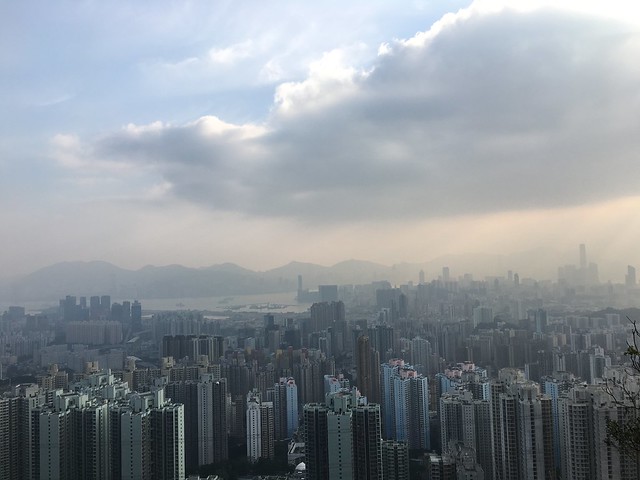
Picture 1. View from Lion Rock in the Kowloon District of Hong Kong, 2015
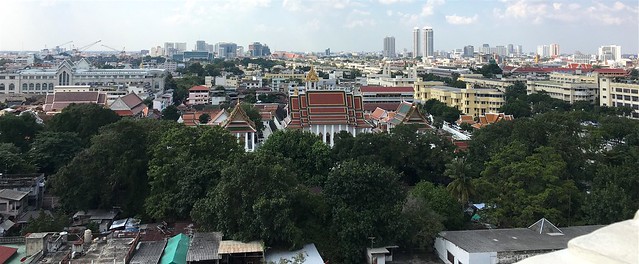
Picture 2. View from Golden Mount Temple in Bangkok, 2015

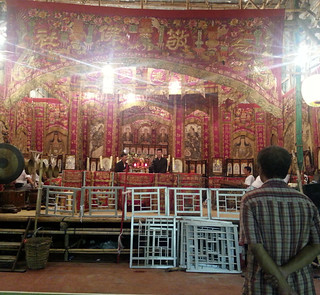
Picture 3 and 4. Yu Lan Festival in Hong Kong
Temporary performing stages constructed of bamboo are built in various locations in Hong Kong at the end of the summer every year. The stage performance and the music are familiar sights and sounds for most locals. The accompaniment by a live music ensemble resembles that of the Cantonese Opera. However, the lyrics and recitatives are performed in Chiu Chow, a dialect passed on primarily through family education and spoken within various communities with Chiu Chow ancestry across Southeast Asia.
Should we recognize the Yu Lan Festival as a key sonic event in Hong Kong? Does it constitute a representative soundscape? At a local level, the contribution of the Chiu Chow population is highly significant within the demographic structure and cultural heritage of Hong Kong. Yu Lan is a major event during which the descendants of Chiu Chow and their extended families reunite in rituals and ceremonies that can be traced back to medieval China. As Stephen Teiser pointed out, the Yu Lan Festival is one of the “enduring components of Chinese socio-religious life: mythology, ritual, cosmological conceptions, religious virtuosi, the ancestral cult” (Teiser 1988: 217). At a regional level, a festival for hungry ghosts is not unique. Variants can be found in a number of countries across Southeast Asia, including Thailand, Vietnam, and even countries outside the region, such as Japan. It is a common cultural ritual in the cultural zone of Far East Asia.
Case 2: Traditional Thai music at Ratchadamnoen Stadium in Bangkok
Ritual music making is also a feature of Thai boxing (also called Muay Thai: มวยไทย). Boxing matches are held almost every day in Ratchadamnoen Stadium (สนามมวยราชดำเนิน) in Bangkok. The cheering sounds in the audio footage are not produced by tourists, but primarily by middle-aged male Thai locals who were actively participating in gambling activities during each match. The tourists, despite sitting in the top-price zones, generally refrain from applauding loudly or cheering. At the beginning of each match, the boxers perform ritual dances before fighting. The entire athletic event, including the ritual dances, is accompanied by a Thai traditional music ensemble composed of wind and percussion instruments. The live music performed during all matches is highly improvised.
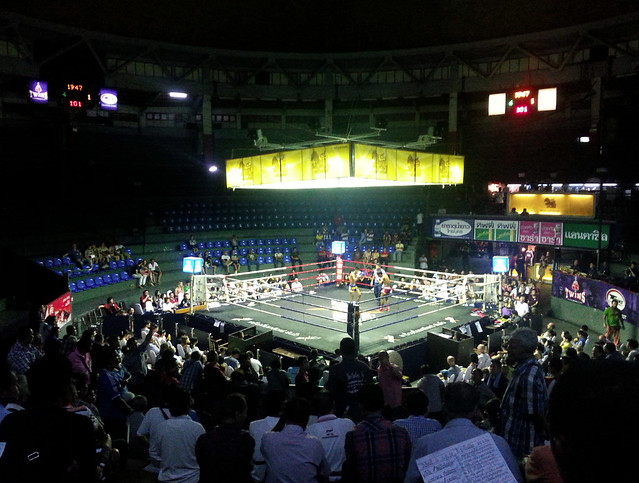
Picture 5. Ratchadamnoen Stadium in Bangkok
Originally a regional martial arts practice, Muay Thai is now a world sport. However, Thai music might not always be performed in matches overseas. The soundscape in Ratchadamnoen Stadium ironically includes human voices from the senior communities, arising from their associated gambling activities, alongside the ceremonial music. As such, the combination of these sonic elements in the stadium soundscape is a unique phenomenon in the region.
Case 3: Midnight mass at Catedral Igreja da Sé in Macau
Another remarkable soundscape with music is the midnight mass sung in Catedral Igreja da Sé (澳門主教座堂) in Macau, an ex-Portuguese colony in the west of Hong Kong. The cathedral is a historical Catholic hub in the city, an iconic location where the influence of European religious music traditions in Southeast Asia resulted in masses, such as Dominus dixit ad me and Missa de Angelis, being sung in Latin instead of Cantonese or English. This religious practice can be traced back to the colonial history of the peninsula during the European Age of Exploration from the fifteenth to the seventeenth century.
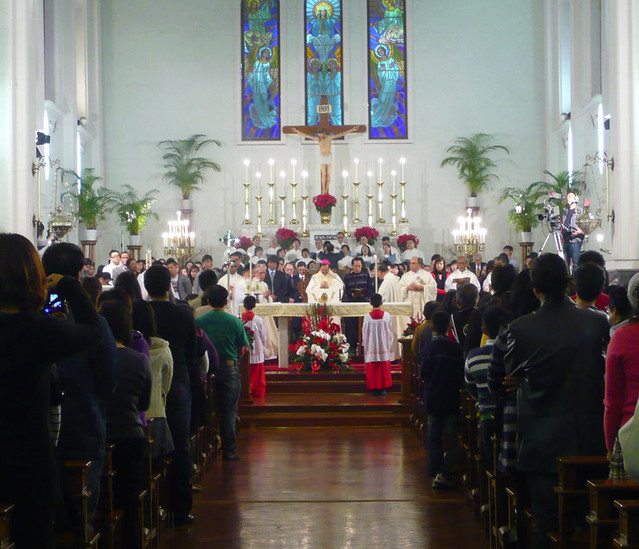
Picture 6. Midnight mass at Catedral Igreja da Sé in Macau
Audio file 3: Dominus dixit ad me
Audio file 4: Missa de Angelis
The liturgy and sermons are delivered in Portuguese and Cantonese, however. None of the languages sung and spoken are the official language of Mandarin (i.e. the official language of mainland China), although Macau was said to be “reunited” with mainland China since the handover of sovereignty in 1999. Given that the majority of people in Macau are native Cantonese and Macanese (Macau-born people with Portuguese ancestry) since the mid-sixteenth century, the acoustic phenomenon is highly consistent with the current demographic situation. For people outside Macau, this may be a unique linguistic and sonic experience, perhaps especially remarkable for visitors who spent their teenage years in one of the Catholic schools in Hong Kong, where they were taught to sing and pray in either English or Cantonese.
Case 4: The voice of a Taiwanese singer in Chinatown in Bangkok
While the historic-cultural significance of ritual or religious activities is readily recognized, the “secular” side of musical soundscapes in urban areas forms an intriguing counterpart. Imported pop songs, for instance, may reveal aspects of the contemporary history of regional politics. Blasting via an overamplified loudspeaker on Yaowarat Road (the core of Chinatown in Bangkok), Teresa Teng’s (鄧麗君) voice can frequently be heard along the main road. Audio file 5 features a remixed version of her vintage piece “Memory is only for remembrance” (Original Chinese title: 往事只能回味), originally the theme song of a Taiwanese movie of the same title released in 1971. Her popularity has lasted for decades within Southeast Asia, and even Japan, reflecting an influence of Taiwanese musical culture in the region since the 1980s. Teresa Teng was a rare exception, a Taiwanese musical icon with traces of the “petite bourgeoisie” (Kristof 1991), deemed permissible for the working class in communist China during the 1980s. A phenomenal singer who had served the nationalist Chinese army in Taiwan (Republic of China, ROC), her signature singing style unavoidably reveals its cultural heritage as derived from traditional Chinese society, also referred to as “old China” by the communists. Since Bangkok and the north of Thailand formed refugee zones for those fleeing the Chinese national army (Kuomintang) during the civil wars of the late 1940s, Teresa Teng’s popularity in Bangkok’s Chinese community reveals the soft diplomacy between Taiwan and Thailand during the 1980s and the Southward policy implemented by Taiwan since 1994 (Ku and Ho 2005: 264).
Audio file 5: Vintage Chinese pop songs played in Yaowarat, Bangkok


Picture 7 and 8. Chinatown in Bangkok
The voice of Teresa Teng embodies a collective memory for the Chinese communities in Southeast Asia, and her songs are played much more frequently in Bangkok than in Hong Kong. The Thai-Chinese community still perceives Teresa Teng as a legendary figure deserving unlimited replay, even after her unexpected death during a vacation in Thailand in 1995.
Case 5: A flea Market at Sham Shui Po in Hong Kong
Soundscapes with nostalgic elements are heard not only in Bangkok; similar sonic experiences can be found in the Sham Shui Po (深水埗) district of Hong Kong. A half-century ago, the district was frequented by middle class entrepreneurs and sea traders (陳雲, 甄小慧 2015). It is now a major trading hub for used household items and vintage collections. Senior citizens subsisting below the poverty line and other economically deprived communities inhabit this densely populated district. Cantonese opera music is played by street vendors and emanates from some old stores. The soundscape retains elements from the recent era of radio. Since 1978, Cantonese opera music was broadcast via a government-owned radio channel, RTHK radio 5 (劉靖之 2013: 312), serving mostly the locals (especially the elderly) in the city, including some of my senior relatives. With increased immigration from South Asia and mainland China, the element of Cantonese opera in Sham Shui Po district’s soundscape is not as prominent as before, as it is now mixed with Indian and other popular genres, reflecting the demographic changes in the district.
Audio file 6: Cantonese opera music, Location 1
Audio file 7: Cantonese opera music, Location 2
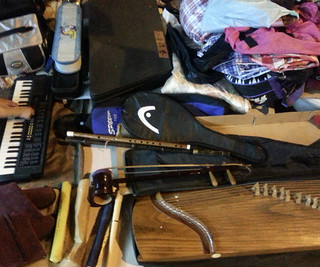
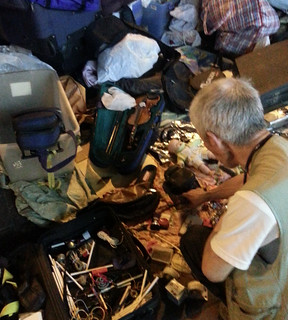
Picture 9 and 10. Flea market in Sham Shui Po, Hong Kong
What do the urban soundscapes of a city represent?
Case studies in Bangkok and Hong Kong
Kaho Cheung
What surveys or studies can be found, associated with the urban soundscapes of these cities with such dynamic geopolitical and social situations? While most attention is devoted to their political and economical transformations, their urban soundscapes remain underexamined. A small number of substantial soundscape projects associated with the two cities can be found, including web-based soundscape recordings, soundmaps, audio interviews, sound installations and exhibitions. Traditional cultural practices and recent political events have been a source of creative scholarly research in Hong Kong. Notable projects include The Cheung Chau Bun Festival: A Hong Kong Soundscape Study, a soundmap project featuring a traditional festival and the ceremonial activities in Hong Kong, led by ethnomusicologist Manolete Mora (2009). The origins of the festival and other contextual information are well documented in English, accompanied by photos and audio materials. This kind of professionalism in documentation is rare in within the region. Based on a major political movement, The Umbrella Movement - Field Recording Investigative Project(雨傘運動 - 田野錄音調查) (Law 2015) is a case study. It features audio interviews correlating sound and “bona fide social movement” during the 79-day Umbrella Movement, a series of sit-in street protests, in Hong Kong in 2014. Produced by a group of local sound artists, The Library By Soundpocket in Hong Kong, the project was aimed to embrace “sound as a tool of resistance.” There is also a survey of urban spaces, Soundscape of Urban Open Spaces in Hong Kong, conducted by Hui Lin and Kin-che Lam (2010). The study selected 25 urban open spaces of various sizes and types in six districts with distinctive surrounding land-uses and development histories. The researchers surveyed and conducted interviews with the 1610 visitors, analysing the impact of acoustic preferences on the perception of acoustic quality, thus giving insight into possible interventions in soundscape design. This project was designed to study the perception of sounds and how desirable they were found to be at various specific urban locations, including Sham Shui Po, Yau Tsim Mong, Central and Western, Wan Chai, Sha Tin and Tai Po. Some of the locations, such as Sham Shui Po, are also included in this article. The research found that the majority of visitors preferred sounds from nature – such as birds, water and winds – to sounds from traffic and construction sites. The presence of “wanted” sounds, rather than actual noise level, contributes most to the perceived acoustic quality of an urban location. However, discussion of the socio-cultural context of the soundscape recordings and the results of the survey were not included.
In Bangkok, two notable soundscape projects can be found. Featuring a major river in Thailand, the Chao Phraya Bangkok River Project was produced by musician Mike Cooper (2012). The project consists of a collection of documentation materials and artworks based on audio and video footage made at the floating station platforms, ferry boat, and riverside in the Bangkok area. With ambitions stretching across the whole Southeast Asia region, the As((ear))n Project (Asearn ประสบการณ์หู สู่อาเซียน) “introduces minute elements of the entire environments, which are parts of cultural and ecological lives of Southeast Asia.” In line with this goal, they created a sound installation and exhibition in Museum Siam in Bangkok (Mukdawijitra 2015), alongside a web-based archive that is still under expansion.
The aforementioned soundscape projects consist of audio materials, written descriptions, installation, and web-based archive. Their foci span across traditional festivals, political events, and soundscapes within the Southeast Asian region. The narrative approach of the Chao Phraya Bangkok River Project was an excellent reference for these case studies, as it demonstrates how a balance between narrative and audio materials can be achieved. The Cheung Chau Bun Festival: A Hong Kong Soundscape Study also informs this research in the way it approaches traditional rituals as carrying histories and memories of a particular community. They can be insightful for the study of a particular urban event and cultural practice. This article, however, aims to provide an overview of the urban soundscapes of two major cities within the region and their associated socio-cultural contexts.
While the body of existing soundscape projects in Hong Kong and Bangkok may not necessarily form the best source of insights for this research, an article concerning the urban soundscape in Indonesia, written by anthropologist Freek Colombijn (2007), can help in framing a panoramic perspective of the urban soundscape. According to Colombijn, his article is an “exercise“ of urban soundscapes in Indonesia, aiming to “introduce soundscapes as a valid and fascinating research topic, using an anthropological-historical methodology.” Colombijn introduces four themes to describe the urban soundscapes in Indonesia: the sounds of the street, the sounds of power, the sounds of modernity, and the sounds of intimacy. The themes are not well-defined, but the self-explanatory titles and his narrative approach does provide deep insights into the socio-cultural contexts of some distinctive urban soundscapes in Indonesia. He uses “noisy” as a general descriptor for the sonic environment of Indonesia, while stressing the subjectivity of noise as articulated by Murray Schafer (1994). He also provides a culturally-sensitive discourse on the “noises” of the country, as some of them convey the sonic character of a local place or a city. He provides no audio footage supporting his descriptions of various soundscapes. The contextual information is highly impressionistic and primarily based on his personal experience, such as his attendance of a wedding ceremony in Yogyakarta and his aural experience of the Sakai people. His narrative approach and his four themes of urban soundscape, nonetheless, resonate within the scope of this article. Further discussion is offered in the concluding remarks.
Based on a collection of audio footage, visual images and textual description, this article presents a number of case studies of urban sounds in the metropolitan areas of Bangkok and Hong Kong. An “exception” is a case study from Macau, a city close to Hong Kong, which is included in order to enrichen the observations. Primarily recorded with binaural microphones, and at one point stereo condenser microphones (between 2007 and 2015), audio footage includes broadcasts at rail and metro stations, vintage Thai pop songs played on buses, flea markets, the sounds of bells and shouting with meat-chopping noises from street vendors, improvisations by street performers, mechanical sounds produced by double-decker trams, and midnight mass on Christmas Eve. The socio-cultural or economical contexts within which the urban sounds arise are discussed. It is hoped that the observations of the urban soundscapes offered here will invite further investigation within sound studies and other disciplines rather than serving as a stand-alone theory for soundscape analysis for the region. Instead of focusing on a specific event or traditional festival, the article attempts to reflect the diverse and eclectic nature of urban sound environments in Bangkok and Hong Kong. This study offers 15 cases studies and 28 audio recordings as aural reference points. While I believe that audio footage is the best material for conveying the nuances of the various urban soundscapes, a textual accompaniment – a written form of soundscape – serves to verbalize their distinctive features, history and cultural contexts. This mode of presentation creates a balance between visual, audio and textual information in the representation of the collected soundscapes offered here.
Case 1: Yu Lan Festival in Hong Kong
With their dense populations, limited public spaces, and strict fire safety regulations, the urban areas of Hong Kong do not accommodate many large scale ritual activities. The Yu Lan Festival (盂蘭勝會) is an exception. Based on the story of the hungry ghosts from the Ullambana Sutra (佛說報恩奉盆經) of Mahāyāna Buddhism, the festival has recently been inscribed by The United Nations Educational, Scientific and Cultural Organization as an “intangible cultural heritage” (UNESCO 2011). During the festival, the people of Chiu Chow gather together and donate money for future community events and ritual activities. As an integral part of this festival for the starving ghosts, Chiu Chow opera performances are performed from nightfall to midnight, as the ghosts are believed to be nocturnal beings.
Case 12: The vintage rail system in Bangkok
Besides the “chaotic” scenes found in the old street markets, mechanical sounds from the vintage diesel locomotives can still be heard in Bangkok and its nearby provinces. The State Railway of Thailand (SRT) still operates Japanese-built rolling stocks, purchased decades ago. For the Japanese, these are the sounds of old trains, as most of the rolling stocks are dated models manufactured by Japanese train builders. It is also known that used Japanese rolling stocks are sold to Thailand and other Southeast Asian countries from time to time. The soundscapes, both inside and outside, of vintage Japanese trains may therefore be a regional phenomenon.
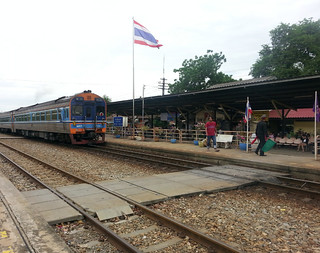
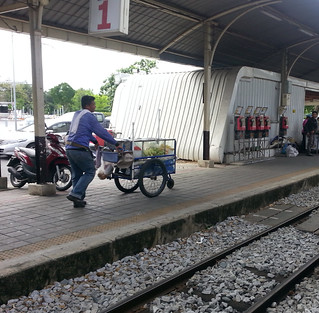
Picture 28 and 29. State Railway of Thailand (SRT)
Audio file 19: Taling Chan station
Audio file 20: Fruit Vendors at Bang Sue Junction
Audio file 21: Train arriving at Hua Lamphong Station
The manually-triggered horn sounds, the occasional doppler effects of passing trains, the bell sounds of street vendors in the rail station, the calls of snack vendors on board, and the rumbling sounds captured from the interior of the rolling stocks constitute a distinct sonic voyage, although the slow speeds and unpredictable schedules may not be practical for people in urban areas.
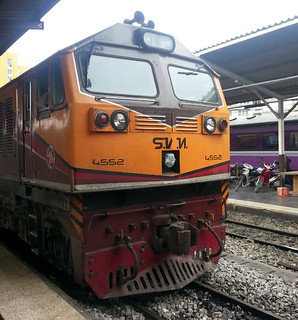
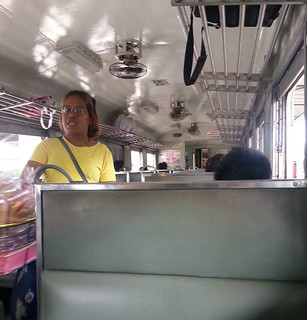
Picture 30 and picture 31. State Railway of Thailand (SRT)
Case 13: The historic double-decker tram system in Hong Kong
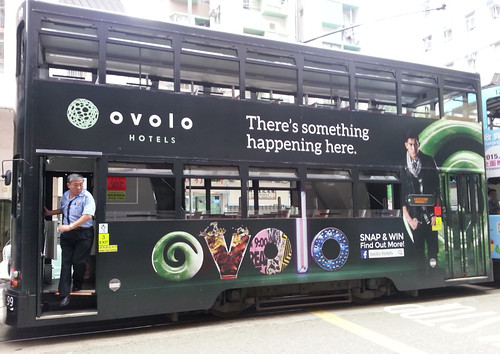
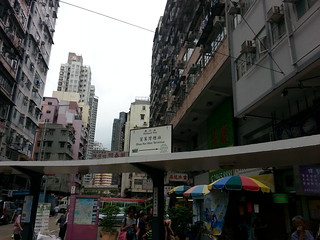
Picture 32 and 33. Double-decker tram and tram terminus in Hong Kong
Audio file 22: Double-decker tram
Even more historically significant is the double-decker tram system in Hong Kong. It has been serving the north of Hong Kong Island since the colonial period. The most iconic sound is the “ding-ding” (叮叮) of the tram bell, triggered by the driver upon departure. As a striking “sound signal” (Schafer 1994), “ding-ding” has become a nickname for double-decker trams among the locals. If put in Truax’s (2001) framework of acoustic communication, it serves as a keynote sound in the North of Hong Kong Island. The British Empire developed several double-decker tramways in some of her colonies. The tramway in Hong Kong is one of the most historically significant tramways in the world and is still under heavy usage. Completed in 1904, the system has been an urban icon for many filmmakers and even game designers. Audio file 22 was collected from Sau Kei Wan Terminus, a well-known roundabout for the trams to “turn around” for their westbound journey heading to the Western Market Terminus.
Case 14: Automated metro systems and musical sounds found in Hong Kong and Bangkok
In contrast to the slow-speed rail systems, the BTS and MRT in Bangkok are definitely a punctual solution for working people. Probably the most automated mass transportation system in the city, the automated broadcast onboard by vocal talents Radklao Armradit and Sarocha Pornudomsak (Barrow 2014) bring passengers the most remarkable Thai voices, especially for foreigners who first visit the city. Compared to other metro system sounds – such as those of Japan, Hong Kong, Berlin, London, New York, and Stockholm – BTS and MRT are fairly quiet systems. But the sounds of the commercials found on board the BTS can form an auditory intrusion on passengers. Interestingly, there is no music on board the MRT, but music and commercials are broadcasted in the stations. The audio file below was recorded during the Queen’s birthday in Thailand, with lyrics showing gratitude, including “Im-Oun” (อิ่มอุ่น) and “Ka-nam-nom” (ค่าน้ำนม). Played near ticketing machines, Beethoven’s Für Elise (audio file 25) was set to a never-ending loop in the metro system of Hong Kong. The audio display was found at Kowloon Tong Station in mid-2007, a few months before Hong Kong Mass Transit Railway (MTR corporation) took over Kowloon Canton Railway (KCR). It was installed as part of the tactile map for the blind and visually impaired.
Audio file 23: Inside the MRT
Audio file 24: Inside the BTS
Audio file 25: Music and commercials in the MRT station
Audio file 26: Beethoven’s Für Elise and the tactile map

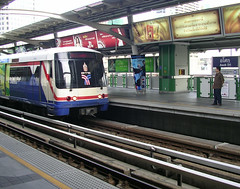
Picture 34 and 35. The BTS Skytrain and the onboard commercials


Picture 36 and 37. The MRT in Bangkok
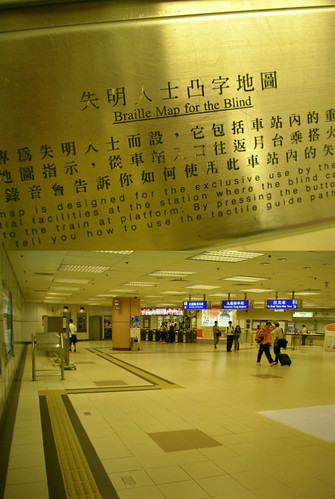
Picture 38. Tactile map at the Kowloon Tong Station
Case 15: Diesel bus trips in Bangkok
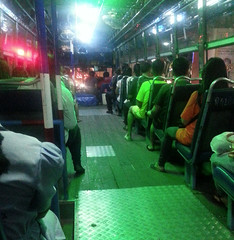
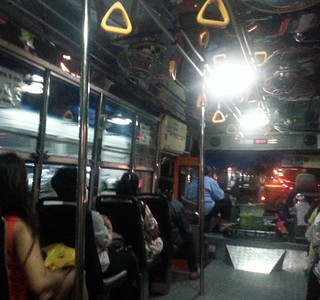
Picture 39 and picture 40. Bus 25 and bus 46 in Bangkok
Along with the rail transport, public buses constitute moving sound objects in Bangkok. They also form the “keynote sounds” (Schafer 1994) of the city. The sounds produced by the engines can easily be identified as a major source of noise pollution. The most noisy experiences are definitely from those buses without air-conditioning. Bus 25 and bus 46, for example, are equipped with wooden floors, invariably opened windows, aging but fully working engines, and dated ceiling-fans, actualising a sound image distinctive from other “advanced,” air-conditioned modes of transportation. According to a recent decision of The Bangkok Mass Transit Authority (BMTA), the old buses will soon be replaced by new electric buses and vehicles running on natural gas (Mahitthirook 2016). It is expected that the soundscapes of the major routes, such as Sukhumvit Road, will be extensively revitalized. The noisy buses may become part of a shared social memory (Järviluoma 2009) that most likely will not become part of the sonic experience of future generations.
Audio file 27: Bus 25 at Phra Khanong
Audio file 28: Bus 46 at Udomsuk
Case 10: Intense bird songs in a densely populated city
Audio file 13: Yuen Po Street Bird Garden (園圃街雀鳥花園)
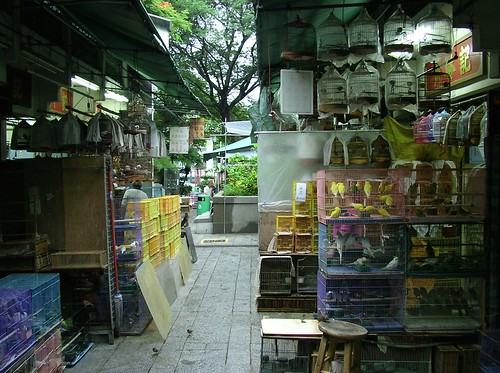

Picture 18 and 19. Yuen Po Street Bird Garden
Keeping birds as pets forms a longstanding tradition within the Chinese community. “Playing with a caged bird” (撚雀) has been an indispensable cultural practice within the Chinese tea house tradition. The intense bird songs of caged birds in audio file 13 may sound inappropriate to the ears of an animal rights activist. However, one might say that the high-density living in this bird market does certainly reflect that of the Hong Kongers. A Chinese tea house named Ki Heung Tea Restaurant (奇香茶樓) was originally located in Hong Lok Street in Kowloon, with customers spending their mornings with their caged birds in the1960s. (星期日生活編輯組 2013: 36-37). A large number of bird sellers set up and operated their businesses in this area for decades, and Hong Lok Street organically evolved into “the little bird street” (雀仔街), a nickname for this major bird market area in the 1980s. It was an iconic landmark shared by tourists and locals. Due to city redevelopment in recent years, a huge shopping mall, Langham Place (Picture 18), was built. The street stalls with birds were relocated to Yuen Po Street Bird Garden in 1997, followed by the permanent closure of the stalls on Hong Lok Street in 1998. It is a rare example of an iconic soundscape being relocated to new premises without disappearing completely. However, the relocation plan has come under criticism, as the integrity of the street culture of the original location was never restored. Applying Ruth Glass’s (1964) term, this can be regarded as a classic example of “gentrification.”
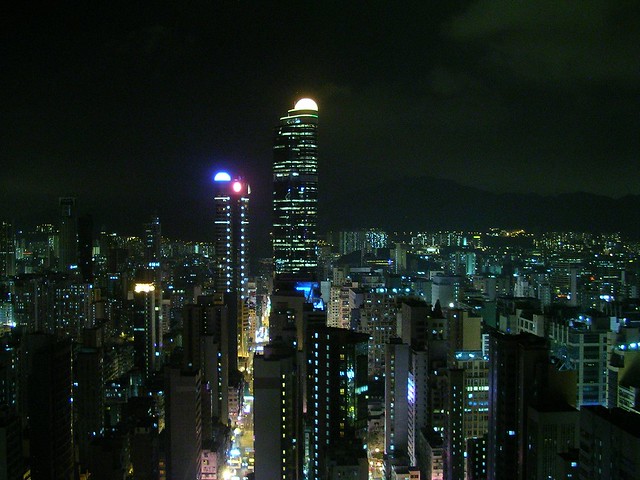
Picture 20. The original location of the bird market is redeveloped into a major shopping mall, Langham Place (the tallest building at the center of the photo)
Case 11: A major fresh produce market in Bangkok and a street market on the sloping streets of Hong Kong


Picture 21 and 22. Khlong Toei Fresh Market
A major wholesale and retail hub for livestock, vegetables, seafood, and other fresh or processed food, the sonic multiplicity in Khlong Toei Market (คลองเตย) goes beyond average “market” soundscapes in Bangkok. Street-bargaining, price-shouting, meat-chopping, vendor cart rumbling, ice-breaking machines roaring, kids laughing, and Thai vintage songs permeate the market. The sounds are chaotic, yet highly organic and human-generated as compared to the automated broadcasts and cashiers found in the “modernized” supermarkets. In the Khlong Toei Market, the locals can meet and chat with the vendors as they do with their relatives and neighbours.
Audio file 14: Bargaining, Khlong Toei Market
Audio file 15: Motorcycle passing a wooden bridge, Khlong Toei Market
Audio file 16: Ice-breaker machine, Khlong Toei Market
Audio file 17: Watermelon stall, Khlong Toei Market
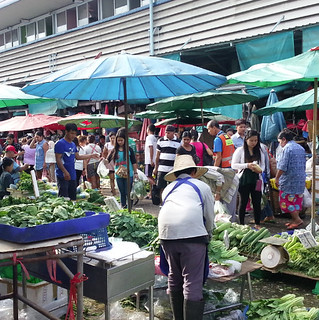

Picture 23 and 24. Khlong Toei Market and the wooden bridge at one of the entrances
Neither required to dress in uniform, nor monitored by a store manager, the stall vendors are free to talk whenever they find it productive and rewarding. The owner of a watermelon stall and his friends are watching Muay Thai and cheering (audio file 17). Without glass or brick walls to block the sound, the medley of market sounds, enclosed by tall buildings on the gently sloping streets, might be perceived as a sort of improvised symphony issuing from a roofless concert hall. A comparable example in Hong Kong is the Shui Wo Street fresh food market, an old fresh food market located in a city of skyscrapers.

Picture 25. Shui Wo Street in Hong Kong
Audio file 18: Shui Wo Street market
The sloped market area is much smaller than the Khlong Toei Market, but the sounds of the open market space do resemble its Bangkok counterpart. Due to urban revitalization, traditional fresh markets of this kind have been replaced by multistorey, air-conditioned market buildings or the fresh food sections in supermarket chains. Preserving the soundscapes in those fresh markets can be a meaningful and time-critical mission. As observed by Jean-François Augoyard in his study of daily sonic experiences:
Density and crowds create metamorphosis sound milieus; this is even more so when the space favours diffuse propagation. Undoubtedly, the metamorphosis is culturally significant in the perception of a collective sound environment.(Augoyard and Torque 2005: 77)
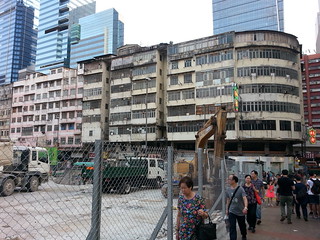
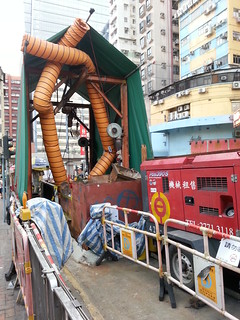
Picture 26 and 27. Redevelopment near Shui Wo Street
Concluding remarks and discussion
An urban soundscape is an acoustic phenomenon, carrying the histories, memories, and cultures of a particular urban place or community. One question central to all case studies and audio files is: do the soundscapes represent the city?
To quote Catherine Guastavino’s words (2006: 950): "the ideal urban soundscape reflects life!" The locals are generally the most qualified people to which the question can be addressed, as they are continually exposed to the sonic events of a city. As a resident of Bangkok and Hong Kong for various stretches of time, I collected audio footage first-hand, while the contextual information is based on existing literature and online research. The selection of representative soundscapes is largely based on personal aural experiences, especially in Hong Kong, my hometown. As for Bangkok, the knowledge of the locality rests largely on my past experiences as resident. Subjectivity and bias cannot be eradicated in the apprehension of the urban soundscape. As Elen Fluegge (2011) points out, “it is tricky to make qualitative claims about the soundscape of an area in part because two people sharing common geographical space might not share the same sound space at all.” It is reasonable to assume that the representational value of recorded soundscapes requires further examination. The reasoning process accompanying the collected sounds can lead us beyond materialistic features into a further investigation of their socio-cultural contexts. Through the accumulation of individual audio documentations, the fundamental characteristics of urban soundscapes might be consolidated into a collective aural memory. In other words, the case studies presented in this article form a beginning, not the end, of this type of research.
The representational value of an urban soundscape can be complicated by its historical and cultural context. In the case studies of Khao San Road and Daiso Store, the presence of foreign music cultures can be heard as a highly invasive element. One does not need any professional knowledge to recognize that this music originated outside Bangkok and even Thailand. If one were to build a sound archive for Bangkok, these certainly do not represent the sounds of the city in terms of endemic Thai culture. But in a broader cultural context, they do reflect the diversity of sounds and the aural dominance of foreign cultures in some urban locations within the city. At the same time, imported cultures of the past might become the local cultures of the future. The midnight mass found in the Catholic Church of Macau and the Mor Lam street performance heard at Sathorn Pier in Bangkok are among the best examples of “localized” imported urban sound phenomena. Local auditory culture can also emanate from colonial infrastructures of the past, such as the double-decker tramways of Hong Kong. Some urban sounds can be traced entirely to local agencies, but void of ties to the local history of the city, such as the live music performances at the Artbox Bangkok Container Flea Market. There are clearly ambiguities when defining the localness of urban soundscapes.
To quote Freek Colombijn’s (2007) words, “the anthropological difficulty [...] lies in the question of what sounds mean to the local people.” A similar difficulty exists when deciding which urban soundscape should be chosen to represent Bangkok and Hong Kong. If a soundscape issues from completely foreign events, does it mean that they are irrelevant to auditory research?
Even if an urban soundscape consists exclusively of foreign elements, with no local sounds (local language and traditional music, for example), they can be included in the research if they have an impact on the lives of locals. I have refrained from purifying the scope of this research to include only the so-called “authentic” aspects of the musical or street culture in the two cities. For example, the Yu Lan Festival in Hong Kong and the Thai Boxing scene do not dominate the discussion, despite the fact that the music and audible activities in the soundscape are oriental in their cultural context and coming from more long-standing traditions. Instead, an inclusive approach has been adapted in this research. The foreign music culture in Khao San Road, for example, are included as they represent the bar culture and impact of tourism on Bangkok, which extensively impacts the lives of locals. In short, the study of urban soundscapes is not obliged to authenticate the culture of a city, but to unfold the sonic reality of an urban place.
While most of the audio footage in this article is associated to street culture and the modernised infrastructure of the cities, three of Freek Colombijn’s four themes of urban sounds resonate within the case studies. The Mor Lam (หมอลำ) performance near Chao Phraya River in Case 7 and Klong Toei Market in Bangkok and Shui Wo Market in Hong Kong in Case 11 can be ascribed to sounds of the street. The automated metro systems and musical sounds found in Hong Kong and Bangkok in Case 14, the live music at Artbox Bangkok Exhibition Flea Market in Case 6, and the double-decker tram system in Hong Kong in Case 13 can be classified as sounds of modernity. The national railway in Bangkok in Case 12 can be aligned with the sounds of power. It is also interesting to notice that the themes are not mutually exclusive. The Diesel bus trips in Bangkok, for example, can be attributed to the sounds of modernity as well as the sounds of power.
However, the article cannot fully adapt or be adapted to Colombijn’s categorizations. Despite the fact that the titles of some of them are self-explanatory, the delineation of the themes, in particular the sounds of intimacy, require further elaboration for them to be useful for this research. Some distinctive soundscapes also fall outside the scope of the four themes. The Yu Lan Festival in Hong Kong in Case 1 and the midnight mass at Catedral Igreja da Sé in Macau in Case 3, for instance, cannot be attributed to any of Colombijn’s themes. I suggest that “sounds of belief systems” is one theme that might be added in order to encompass ritual, religious, and other cultural practices associated with any belief system within an ethnic group.
Time is a critical factor when prioritizing sound collection trips, as some urban soundscapes will be extinct sooner than others. Some examples include: the State Railway of Thailand, Klong Toei Market in Bangkok, Shui Wo Street Market in Hong Kong, and the tramway system in Hong Kong Island. Open street markets and historical rail systems have been prioritized targets for sound collection. It does not mean that they are expected to completely disappear from the scene, but modernization or revitalization may remove certain, still-existing, nuances from the sonic environment. Whether the extinction process is perceived as urban redevelopment, “gentrification of the city” (Glass 1964), or “urban revolution” (Lefebvre 2003), the eradication of street culture and small commercial clusters go hand-in-hand with the growing presence of global corporate complexes. The local flavor of urban sounds are diminishing in the face of the revitalization of urban space. In Bangkok and Hong Kong, urban restructuring is extraordinarily fast-paced due to state-led gentrification.
Concerning the variety of sound sources, some key urban soundscapes have not been covered in this article. For example, street music performances in Hong Kong are not presented. This is partly due to the strict regulations limiting public performances in the city. Music performances can still be found at the ferry pier in Tsim Sha Tsui and the industrial district in Eastern Kowloon, but have not been included here. Regarding the commuting systems, the scope of this article is limited to land transportation systems. Marine transport has yet to be investigated, including locations along the Victoria Harbour in Hong Kong and the Chao Phraya River in Bangkok.
Another major opportunity lies within the investigation of demographic patterns and languages. Bangkok is an international city where foreign languages – such as American English, German, and Japanese – comprise key ingredients of its soundscape. Mandarin Chinese, on the other hand, has a growing significance in the soundscape of Hong Kong. This is due to the influx of tourists and immigrants from mainland China since the handover of sovereignty in 1997 and the implementation of The Mainland and Hong Kong Closer Economic Partnership Arrangement (CEPA) from 2003. The demographic spread of human voices should be correlated to international and domestic politics. As such, audio footages highlighting multilingual environments could be included in future research.
Recorded sound forms a fundament for auditory knowledge. Textual descriptions, narratives, and conceptual formulations are essential components as well, but cannot replace the material substance of audio footage.[1]In his recent article “Soundscape of the city is about more than decibels,” Blair Kamin (2015) noted that architects and urban designers mostly pay attention to visual design but ignore the importance of acoustic design. In terms of historical record, Colombijn (2007: 256) pointed out that “the historical study of soundscapes clearly suffers from a dearth of data. Photos and all manner of written sources (travelogues, newspapers, and government archives) provide information about the visual townscape, while only sound recordings can provide direct information about sounds from the past. Unfortunately no archives of these recordings exist in Indonesia to balance the libraries, ordinary archives, and photo collections.” Colombijn’s observations are relevant to my own research as well. I welcome further discussion and debate on the value of examining and reflecting on actual audio footage as representation of the urban soundscape. Considering the underrepresentation of sonic knowledge about Bangkok and Hong Kong, this multimedia essay offers an initial engagement with their wide panoramas of social and cultural realities. It will hopefully ignite future research into conceptualisations and methodologies for examining soundscapes in Southeast Asia.
[1] Although auditory knowledge of a remote site depends primarily on recorded sounds, each recording is also a composition. The time and location of sound collection, the capabilities of the recording equipment, the strategies of recording, and the equipment with which the listener plays back the sounds are all human-based choices that have a real impact on the perception and understanding of the sonic environment.
References
Augoyard, Jean-François and Henry Torgue (2005). Sonic Experience: A guide to Everyday Sounds. Montreal: McGill Queen’s University Press.
Baker, Chris and Pasuk Phongpaichit (2009). A History of Thailand. Cambridge: Cambridge University Press.
Barrow, Richard (2014). “The Faces Behind the Voices on the BTS and MRT.”
Bayly, Christopher and Harper, Tim (2007). Forgotten Wars: Freedom and Revolution in Southeast Asia. Cambridge, Mass.: Belknap Press.
Guastavino, Catherine (2006). "The Ideal Urban Soundscape: Investigating the Sound Quality of French Cities." Acta Acustica United with Acustica 92/6: 945-51.
Colombijn, Freek (2007). “Toooot! Vroooom! The Urban Soundscape in Indonesia.” Journal of Social Issues in Southeast Asia, 22/2: 255-273.
Cooper, Mike (2012). “Chao Phraya Bangkok River Project.”
Fluegge, Elen (2011). “The Consideration of Personal Sound Space: Toward a Practical Perspective on Individualized Auditory Experience.” Journal of Sonic Studies 1/1.
Järviluoma, Helmi (2009). “Soundscape and social memory in Skruv.” In Helmi Järviluoma, Barry Truax, Meri Kytö, Heikki Uimonen and Noora Vikman (eds.), Acoustic Environments in Change and Five Village Soundscapes. Tampere: University of Joensuu.
Kamin, Blair (2015). “Soundscape of the city is about more than decibels.” Chicago Tribune, August 15.
Kristof, Nicholas D. (1991). “A Taiwan Pop Singer Sways the Mainland.” The New York Times, February 19.
Ku, Samuel C. Y. and Khai Leong Ho (2005). China and Southeast Asia: Global Changes and Regional Challenges. Singapore: Institute of Southeast Asian Studies.
Law, Yuk-mui (2015). “The Umbrella Movement - Field Recording Investigative Project.” (trans. Winnie Chau).
Lefebvre, Henri (2003). The Urban Revolution. (trans. Robert Bononno). Minneapolis: University of Minnesota Press.
Lin, Hui and Kin-che Lam (2010) “Soundscape of Urban Open Spaces in Hong Kong.” Asian Geographer, 27/1-2: 29-42.
Liu, Ching-chih=劉靖之 (2013). 香港音樂史論:粵語流行典‧嚴肅音樂‧粵劇: 商務(香港)印書館. Hong Kong:The Commercial Press.
Lombard, Denys (2007). “Another "Mediterranean" in Southeast Asia.” Ed. Nola Cooke. (trans. Nola Cooke).
Mahitthirook, Amornrat (2016). “BMTA all set for electric and NGV buses this year.” Bangkok Post, January 10.
Mora, Manolete (2009). “The Cheung Chau Bun Festival: A Hong Kong Soundscape Study.”
Mukdawijitra, Kusra (2015). “The “As((ear))n” project (Asearn ประสบการณ์หู สู่อาเซียน).” Bangkok: Museum Siam.
Ruth Glass (1964). London: aspects of change. London: MacGibbon & Kee.
Schafer, R. Murray (1994). The soundscape: our sonic environment and the tuning of the world. Rochester, Vt.: Destiny Books.
Taylor, J. Milo, Carlos Alves, Xabier Erkizia, Julien Ottavi and Wajid Yaseen (2013). “OA#1: Listening and Mapping the Sonic. Plurality and Wayfaring: Writing the Opensound Project.” Journal of Sonic Studies, vol. 4, nr. 1.
Teiser, Stephen F. (1988). The Ghost Festival in Medieval China. New Jersey: Princeton University Press.
The United Nations Educational, Scientific and Cultural Organization (UNESCO) (2011). “Report on the implementation of the Convention and on the status of elements.” Convention for the Safeguarding of the Intangible Cultural Heritage, Sixth session. Bali, Indonesia November 2011, Periodic Report No. 00611/China: 20.
Tong, Chee Kiong and Chan, Kwok B. (eds.) (2001). Alternate Identities: The Chinese of Contemporary Thailand. Singapore: Times Academic Press.
Truax, Barry (2001). Acoustic Communication. Norwood: Ablex Publications.
Wannaudom, Prayut (nd.). “The Cultural Collision between folk Performing Arts “Molam” and Culture Industry.”
Yen, Ching-Hwang (2013). Ethnic Chinese Business in Asia: History, Culture and Business Enterprise. Singapore: World Scientific Publishing.
星期日生活編輯組 (2013). 街知巷聞──行街. 香港:明窗出版社有限公司. Hong Kong: Crystal Window Books.
陳雲, 甄小慧 (2015). 深水埗 大家捱出頭的地方. 香港:花千樹出版有限公司. Hong Kong: Arcadia Press Ltd..
Acknowledgements:
I would like to thank Sharon Stewart for her help with the English editing. Her suggestions and language support helped bring this article to the English-speaking world. This article was also made possible thanks to the help of many people, including pianist Evonne Lei from Macau; composer Haruka Hirayama, with her detailed explanations of the Japanese songs for kids; music therapist Patchawan Poopityastaporn from Mahidol University; and Chonticha Keskesorn with her knowledge of Thai songs.
